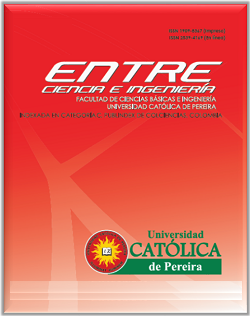Macroinvertebrates as bioindicators of water quality in La Calaboza stream (Yopal, Casanare)
DOI:
https://doi.org/10.31908/19098367.4010Abstract
This study presents the characterization of macroinvertebrates colonizing La Calaboza creek (an important hydric system from Casanare department), to determine the status of water quality and to improve understanding of the native entomofauna, in response to summer and winter conditions. The macroinvertebrates were collected from six sampling stations and identified at the family level. And also, their relationship with various physicochemical variables was established. The environmental status was determined by the application of three biotic indices: BMWP, ASPT, and EPT. Despite the impact of anthropogenic activities, the water quality of the stream was classified as acceptable or good. Regardless of the season, Ephemeróptera was the predominant order in most of the selected stations. However, the winter period presented the lowest biotic indexes, associated with a different distribution of individuals and low diversity, as a result of fluctuations in the physicochemical state of the water. It is concluded that the environmental status of the study area is highly influenced by the change of period, presenting greater susceptibility in winter conditions
Downloads
References
Ocampo, K., Francis, K., Froehlich, O., and Cavallaro, M. R. “Structure
of macroinvertebrate communities in riffles of a Neotropical karst
stream in the wet and dry seasons,” vol. 22, no. 3, pp. 306–316, 2010.
DOI: 10.4322/actalb.02203007
Gamarra, Y., et al. “Aplicaciónn del protocolo CERA-S para determinar
la calidad ecológica de la microcuenca Mamarramos (cuenca Cane-
Iguaque), Santuario de Fauna y Flora Iguaque (Boyacá), Colombia,”
Biota Colomb., vol. 18, no. 2, pp. 11–29, 2018.
Svensson, O., Bellamy, A. S., den Brink, P. J., Tedengren, M., and
Gunnarsson, J. S. “Assessing the ecological impact of banana farms on
water quality using aquatic macroinvertebrate community composition,”
Environ. Sci. Pollut. Res., pp. 1–9, 2017.
Kuzmanovic, M., et al. “Environmental stressors as a driver of the trait
composition of benthic macroinvertebrate assemblages in polluted
Iberian rivers,” Environ. Res., vol. 156, pp. 485–493, 2017.
Moreno, F., Caro, C. I., Pinilla, G. A., and Osorio, D. P. “Estado actual
del conocimiento sobre microalgas del perifiton y macroinvertebrados
bentónicos en el departamento del Meta, Colombia,” Acta Biológica
Colomb., vol. 22, no. 3, pp. 274–306, 2017.
Camacho, J., and Camacho, C. “Aspectos sobre la historia natural de
macroinvertebrados en esteros semipermanentes de la altillanura en el
departamento de Casanare,” Orinoquia, vol. 1, pp. 71–82, 2010.
Paredes, P., and Briceth, K. “Caracterización de los ensamblajes de
macroinvertebrados acuáticos en arroyos del campus Utopía-
Universidad de La Salle (Yopal-Casanare),” 2017.
Roldán, G. A. Bioindicación de la calidad del agua en Colombia: Uso
del método BMWP/Col. Medellín, 2003.
Montoya, Y., Acosta, Y., and Zuluaga, E. “Evolución de la calidad del
agua en el río Negro y sus principales tributarios empleando como
indicadores los índices ICA, el BMWP/COL y el ASPT,” Caldasia, vol.
, no. 1, pp. 193–210, 2011.
Torrentes, M. P., et al. “Aplicación de tres índices bióticos en el río San
Juan, Andes, Colombia,” Mutis, vol. 6, no. 2, pp. 59–73, 2016.
Castro, G., and Sosa, M. “Descripción de datos climatológicos para el
periodo 2012-2015 en El Yopal (Casanare, Colombia),” vol. Rev. Med.,
no. 35, pp. 73–81, 2017. DOI: 10.19052/mv.4390
Lewin, I., Czerniawska, I., Szoszkiewicz, K., Ławniczak, A. E., and
Jusik, S. “Biological indices applied to benthic macroinvertebrates at
reference conditions of mountain streams in two ecoregions (Poland, the
Slovak Republic),” Hydrobiologia, vol. 709, no. 1, pp. 183–200, 2013.
DOI: 10.1007/s10750-013-1448-2
Suhaila, A. H. and Che Salmah, M. R. “Application of aquatic insects
(Ephemeroptera, plecoptera and trichoptera) in water quality assessment
of Malaysian headwater,” Trop. Life Sci. Res., vol. 28, no. 2, pp. 143–
, 2017. DOI: 10.21315/tlsr2017.28.2.11
Arango, M. C., Álvarez, L. F., Arango, G. A., Torres, E. L., and
Monsalve, D. E. “Calidad del agua de las quebradas La Cristalina y La
Risaralda, San Luis, Antioquia.,” Rev. EIA, no. 9, pp. 121–141, 2008.
Maloney, C. E. “The effects of micronutrient additions on soil
invertebrate activity and community structure along a successional
gradient,” phdthesis, Bowling Green State University, 2017.
Tripole, S., Vallania, E. A., and Corigliano, C. “Benthic
macroinvertebrate tolerance to water acidity in the Grande river subbasin
( San Luis , Argentina ),” vol. 27, no. 1, pp. 29–38, 2008.
Raddum, G. G., Fjellheim, A., and Hesthagen, T. “Monitoring of
acidification by the use of aquatic organisms: With 3 figures and 1 table
in the text,” Int. Vereinigung für Theor. und Angew. Limnol.
Verhandlungen, vol. 23, no. 4, pp. 2291–2297, 1988.
Li, S., Yang, W., Lizhu, W., Chen, K., Xu, S., and Wang, B.
“Influences of environmental factors on macroinvertebrate
assemblages : differences between mountain and lowland,” vol. 190, no.
, pp. 1–13, 2018.
Álvarez, L. F. Metodología para la evaluación de los
macroinvertebrados acuáticos como indicadores de los recursos
hidrobiológicos, I. Medellín: Instituto Alexander Von Hummboldt,






 Revista Entre Ciencia e Ingeniería
Revista Entre Ciencia e Ingeniería .png) entrecei@ucp.edu.co
entrecei@ucp.edu.co.png) ISSN (Impreso) 1909-8367 - ISSN (En Línea) 2539-4169
ISSN (Impreso) 1909-8367 - ISSN (En Línea) 2539-4169 Attribution-NonCommercial 4.0 International (CC By-NC 4.0)
Attribution-NonCommercial 4.0 International (CC By-NC 4.0)
.png) Carrera 21 No. 49-95 Av. de las Américas, Pereira, Risaralda, Colombia
Carrera 21 No. 49-95 Av. de las Américas, Pereira, Risaralda, Colombia